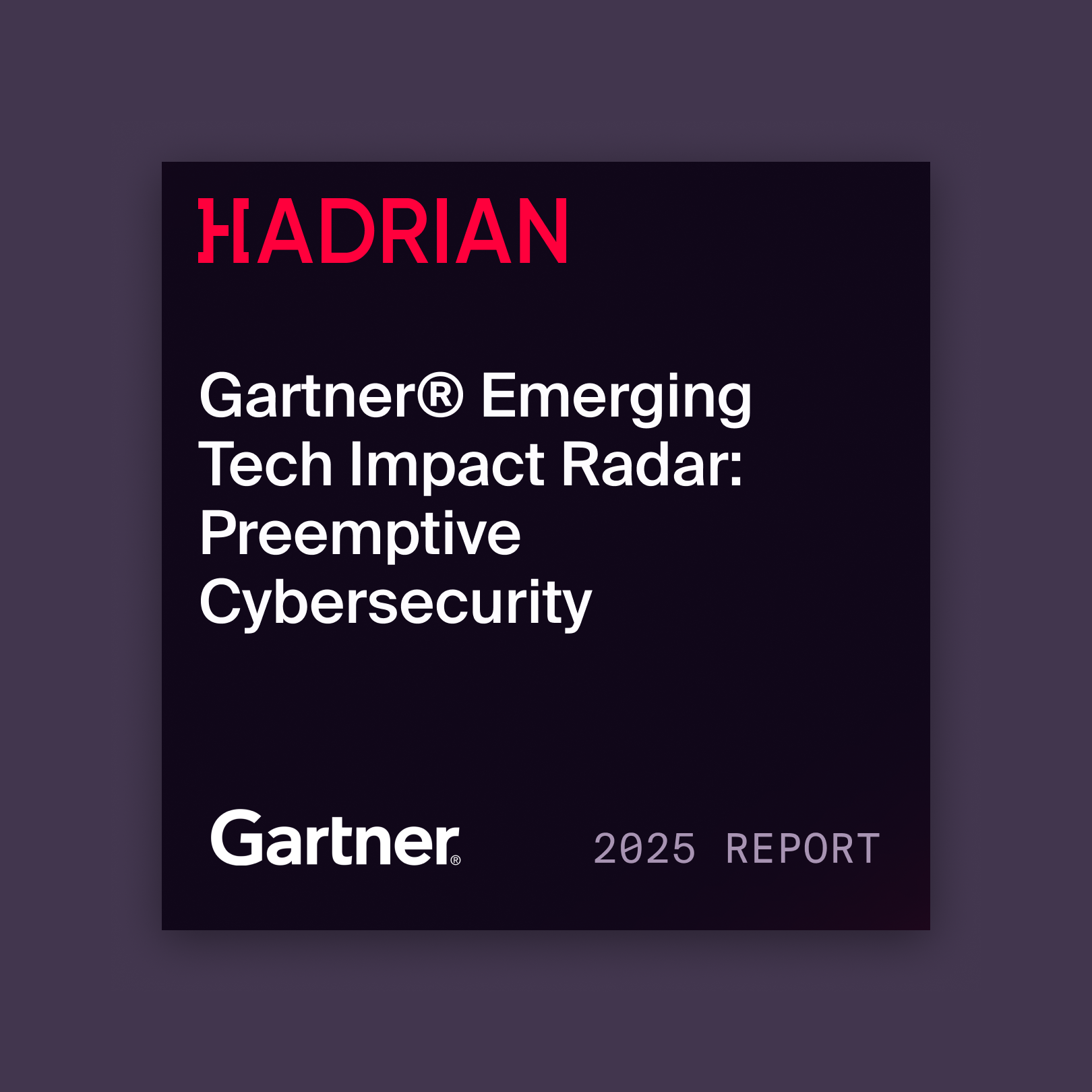
The cybersecurity industry is dynamically evolving, making SecOps a continuous learning role. Each year, the Gartner® Hype Cycle™ for Security Operations, 2025, serves as a crucial compass for security and risk management leaders to strategize and implement SecOps capabilities and functions.. Hadrian is proud to be recognized in this 2025 report as a Sample Vendor for External Attack Surface Management (EASM). However, this recognition highlights a fundamental truth Hadrian has believed since day one: EASM alone is not enough.
Hadrian knows EASM solutions must become full-suite offerings that include Adversarial Exposure Validation (AEV). Hadrian didn't just build an EASM tool; we built a total offensive security platform with AEV capabilities integrated by design, putting us ahead of the curve in delivering comprehensive, agentic AI-driven security solutions.
The evolving security landscape from Gartner's perspective
This year’s Hype Cycle emphasizes a key strategic shift towards a proactive and scalable approach to security operations, especially for organizations with highly complex, cloud-first environments. Gartner notes the advancement of several core technologies supporting threat exposure management programs, including expanding asset visibility, enhanced prioritization capabilities, and innovative approaches to accelerating exposure reduction initiatives.
Gartner also highlights the increasing deployment of AI solutions, with a primary focus on optimizing resources to enhance SecOps centers. As enterprise infrastructure expands, security operations leaders are actively seeking enhanced asset visibility and innovative strategies to boost organizational resilience against rapidly evolving threats designed to bypass existing security controls. This transformation marks a shift from traditional vulnerability management to a more comprehensive exposure management approach, which Gartner deems foundational for improving all SecOps activities.
Crucially, Gartner positions EASM as a critical capability for defending digital assets, but points out that its standalone phase is becoming "obsolete" as its functionalities are increasingly integrated into broader security solution sets like AEV and Cyber Threat Intelligence (CTI). This means the imperative for EASM to evolve beyond basic discovery.
{{hypecycle-cta}}
Beyond basic visibility with precision validation with AEV
Gartner identifies Adversarial Exposure Validation (AEV) as delivering consistent, continuous, and automated evidence of attack feasibility. These technologies confirm how potential attack techniques would successfully exploit an organization and circumvent prevention and detection security controls. AEV achieves this by performing attack scenarios and modeling or measuring the outcome to prove the existence and exploitability of exposures.
For Hadrian, AEV is not an add-on; it is a part of our founding vision. From day one, we understood that simply listing vulnerabilities was insufficient. Our founders, seasoned white-hat hackers, knew that true security required validating exposures from an attacker's perspective. This foresight enabled Hadrian to natively build the capabilities Gartner now advocates for, directly into our platform.
Hadrian delivers total offensive security with agentic AI
Hadrian was ahead of the curve by building AEV capabilities directly into its core platform from inception. Our innovation lies in the application of agentic AI to offensive security, providing a level of autonomy and precision that redefines proactive defense.
Our agentic AI platform delivers:
Continuous Attack Surface Management (CASM): This goes beyond EASM by continuously discovering and inventorying all internet-facing assets with comprehensive contextual details, including shadow IT and Industrial Internet of Things (IIoT) devices. This aligns with Continuous Threat Exposure Management’s (CTEM) emphasis on expanding asset visibility and creating a holistic view of exposures.
Automated Penetration Testing and AEV: Hadrian utilizes Adversarial Exposure Validation (AEV) as a core component of its platform service to proactively identify and confirm exploitable exposures from an attacker's perspective, moving beyond theoretical vulnerabilities to focus on actual threats. Hadrian’s AI emulates real malicious actors, trained by Hadrian's in-house AI and hacker teams to follow threat actor patterns. This enables continuous, autonomous, and targeted testing. Adversarial validation is performed during the "active scanning" phase, which is event-based and triggered when passive scans identify a new theoretical attack path. The purpose is to identify which exposures are exploitable, so remediation teams can focus on what matters most. Active scans are contextually relevant, performing specific vulnerability checks only when they match technologies found on the attack surface (e.g., WordPress scans are not run on SAP systems), minimizing business disruption.
The agentic AI uses contextual knowledge to test for exploitable exposures, including OWASP Top Ten exposures. Scans are chained to simulate complex, multidimensional attacks used by real-world threat actors, uncovering deeper exposures. Hadrian actively assesses and validates a wide range of exposures, including injection vulnerabilities, active subdomain acquisition, unrestricted file uploads, open proxy detection, sensitive file and backup file exposure, credential leaks in exposed configuration files and GitHub environments, API key detection, and misconfigured cloud and Software as a Service (SaaS) tools.
Zero false positives: A major benefit of Hadrian's approach is the elimination of false positives. Hadrian categorizes exposures into "potential exposures" (discovered via passive scanning) and "verified exposures" (actively tested and proven to be exploitable). For every verified exposure, Hadrian provides a dedicated page with a description, severity, impact, remediation instructions, and a "proof of concept." This proof of concept details the bespoke, step-by-step instructions the platform took to validate the exposure, providing verifiable evidence that it is not a false positive and allowing customers to quickly reproduce and confirm the exploit. By actually executing the exploit up to the point of initial access, Hadrian reduces thousands of potential exposures to those that could lead to a data breach.
Exposure prioritization and remediation: Hadrian's validation process directly informs its exposure prioritization. It assigns severity-based exposure scores (Critical, High, Medium, Low, Info) using a stakeholder-specific vulnerability categorization methodology. This prioritization considers factors like business relevance, attractiveness of assets to attackers, discoverability, impact, and ease of exploitation. The platform ensures that critical exposures are addressed within one day.
Continuous improvement: Hadrian's in-house hacker team continuously updates and improves the "hacker agents" used by the agentic AI, enabling the platform to detect new exploits, including zero-days, within 24 hours of their discovery.
Dark Web and threat intelligence integration: Hadrian integrates real-time threat intelligence feeds to identify actively exploited Common Vulnerabilities and Exposures (CVEs) and leverages Infostealer data feeds to detect leaked credentials associated with the organization's domain. This helps prioritize remediation based on real-world exploit activity and provides early warnings of potential account compromises.
Unifying threat exposure management
Hadrian’s single, unified platform natively delivers converged EASM and AEV capabilities, eliminating the complexities and integration challenges associated with managing multiple point solutions. This holistic approach supports the broader CTEM program, where AEV enables deeper automation of the "validation" step.
Hadrian embodies the future Gartner outlines by providing:
- Outcome-driven approach: Our platform scopes the aspects of your business important for its success and correlates asset context, threat intelligence, security configurations, and proprietary algorithms to calculate a more dynamic and evidence-based exposure rating.
- Unified exposure management: We shift from siloed vulnerability assessment tools to a unified platform that combines exposure and attack surface management through AI-driven automation and enhanced prioritization.
- Strong integrations: Hadrian offers robust integrations with existing and planned security tools, broadening attack surface visibility, refining prioritization, and streamlining cross-team collaboration.
- Comprehensive telemetry evaluation: Our platform provides a comprehensive understanding of security by analyzing your technology from the perspective of an attacker, utilizing our advanced AI agents.
Hadrian's total offensive security is future oriented
Gartner’s recognition confirms that the future of SecOps demands a proactive, comprehensive approach to threat exposure management. Hadrian’s agentic AI-driven offensive security platform embodies this future, having built in AEV capabilities from its inception. By providing total offensive security that continuously maps, validates, and prioritizes exposures from an attacker's perspective, Hadrian empowers organizations to get ahead of adversaries, reduce operational overhead, and confidently navigate the complexities of the digital age.



.avif)


